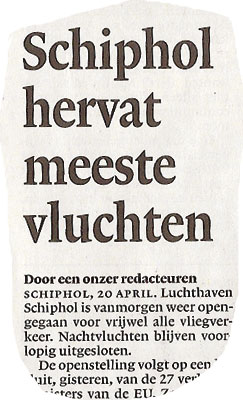It’s not clear how long the volcanic eruption on Iceland will last. Dr. Andy Hooper, of the faculty of Aerospace Engineering’s remote sensing department, is now trying to figure this out. He’s currently processing the data of the activity inside the volcano.
Two weeks ago, during the first phase of the eruption, dr. Andy Hooper was actually standing on the Eyjafjallajökull gletsjer. He watched the eruption. Hooper has been using radar data to monitor this volcano for a long time and was in Iceland to help his colleagues collect more data.
Hooper is now processing the data from the volcano as it comes in: “The eruption’s first phase occurred away from the icecap and the magma dispersed. The second phase however broke through the ice. Because of this, water was involved in the eruption, and this caused the explosions and ash cloud.”
Hopper is surprised by what the data shows. “Every eruption is different, but what’s happening inside this volcano is strange”, he says. “We expected that the magma would come out of a shallow magma chamber, but instead the magma came straight up from deep inside the volcano. That’s unusual, and it makes it hard to predict how long the eruption will last. Normally I’d think it would last until the magma chamber is empty. But now I don’t think the eruption is going to end soon.”
This eruption could trigger an eruption of the much bigger, neighboring volcano, Katla. “If a source of magma goes sideways, it could affect a magma chamber inside the Katla”, Hopper warns. “And the eruption of Katla would be ten times as large, propelling ash higher inside the atmosphere and having an even bigger impact on Europe.”
The plume of ash poses a potential disaster for aircraft engines, says professor of gas turbines, propulsion and energy conversion, Jos van Buijtenen (Aerospace Engineering): “Aircraft engines take in enormous amounts of air. If this air contains ash particles, this can cause a number of disastrous problems. For instance, the particles being pulvarised – rock and glass measuring less than two millimetres – have an eroding effect on the compressor. Because of this, there is less pressure in the engine. A second effect occurs in the combustion chamber, where the temperature is very high and the particles melt and become liquid. When they leave this chamber they meet the cooler turbine blades and solidify again, which causes them to form a glass layer on those blades. This influences the straight flow of air. A lot of high pressure is then needed from the compressor, but the compressor is not able to deliver it because of the ash that’s already inside it. In fact the engine becomes ‘chocked’ and subsequently stops functioning.” And those are not even all the problems the ash can cause. “Therefore it’s the right decision not to fly,” prof. Van Buijtenen concludes
Het is zomer. Komkommerseizoen. Kromme komkommers welteverstaan want ze mogen weer. De Europese Unie heeft de regels aangepast en kromme komkommers mogen weer verkocht worden. Het komkommerseizoen houdt in dat dit soort berichten nieuws is. Iedereen is op vakantie, er gebeurt niet zo veel en de media maakt van alles wat doorgaans saai is een hype. Nu kunnen wij wetenschappers toeslaan. In het komkommerseizoen kunnen wij van de wetenschappelijke benadering een hype maken. Doorgaans is het namelijk te saai, want alles is moeilijk en niets kan zomaar. Wie wil nou horen dat het inpakken van gletsjers in aluminiumfolie een dwaze, zinloze onderneming zal zijn, die de zeespiegelstijging niet zal stoppen? Het is leuker om te denken dat er een simpele en overzichtelijke oplossing is. Een wondermiddel, waardoor je zorgeloos kunt blijven racen en naar de Canarische eilanden kunt vliegen. Waterstof is zo’n wondermiddel. “We laten auto’s toch gewoon op waterstof rijden?” zeggen ze. Als je vertelt dat waterstof nog gemaakt moet worden en dat dit vooralsnog met kolen en uranium gebeurt, ben je spelbreker en doemdenker. Men wil bijvoorbeeld ook helemaal niet weten dat dinosauriërs en mensen niet in dezelfde tijd bestonden, zelfs niet in een tekenfilm. Want dinosauriërs zijn gave beesten en het is saai zonder ze. Populaire wetenschap op tv zal een heel stuk saaier zijn als alle mythen met twee simpele berekeningen worden ontkracht. Dingen opblazen is leuker, ook als het geen nut heeft. Reclame wordt een heel stuk minder spannend met een wetenschappelijke benadering. Je kunt dan niet zeggen dat het gebruik van een crème resulteert in een verbetering van 84.3% van je rimpels. Wat wordt er 84.3% beter aan? Worden ze dieper? Langer? Breder? Of worden het er gewoon meer? Zal nooit de recensie passeren, zo’n tekst. Wij moeten wel snel zijn als we de wetenschap willen hypen. Komkommers zijn tedere vruchten en het seizoen is kort. Voor je het weet, rennen weer 22 kerels totaal onwetenschappelijk achter een bal aan en is de hype voorbij. Maar deze zomer zou van ons kunnen zijn. We kunnen van ons boeiend onderzoek naar Optical inter-domain routing protocols with wavelength converters of Periodicity and a problem of powers a p-adic perspective een hype maken. Gelukkig is er Wimbledon. Lang leve de lol.



Comments are closed.